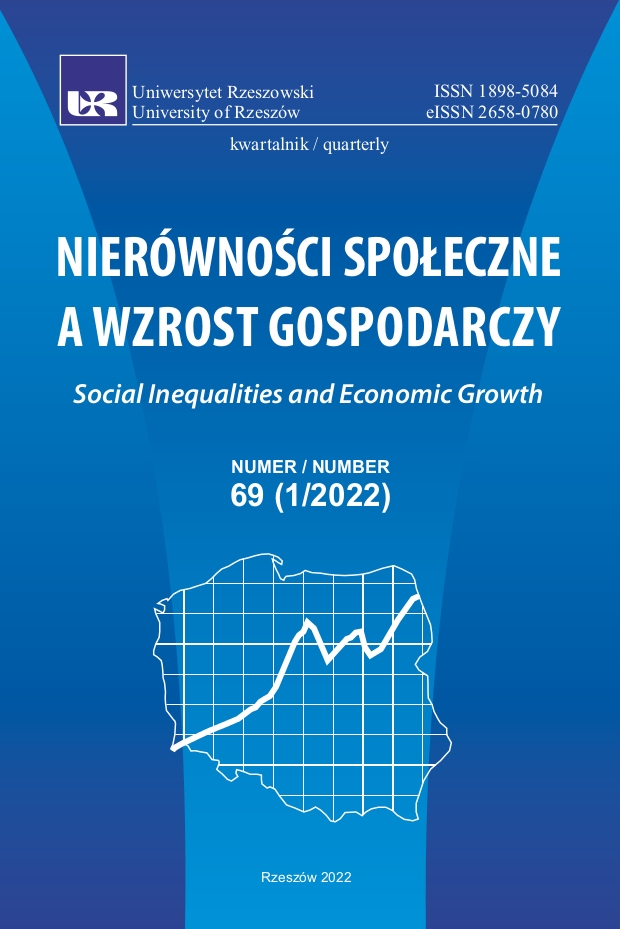Regionalne zróżnicowanie kapitału ludzkiego – analiza na podstawie równania płac Mincera
DOI:
https://doi.org/10.15584/nsawg.2022.1.3Słowa kluczowe:
kapitał ludzki, równanie płac Mincera, analizy regionalneAbstrakt
Głównym celem niniejszego artykułu była próba oceny zróżnicowania kapitału ludzkiego na poziomie polskich regionów (województwa, poziom NUTS-2). W tym celu wykorzystano nieidentyfikowalne dane jednostkowe pochodzące z badania przeprowadzonego przez Główny Urząd Statystyczny dotyczącego struktury wynagrodzeń w październiku 2016 roku (Z-12), dane pochodzące z badania aktywności ekonomicznej ludności (BAEL) oraz dane o oczekiwanej długości życia kobiet oraz mężczyzn. Mikrodane GUS z badania Z-12 posłużyły do oszacowania parametrów rozszerzonej regresji płac typu Mincera, osobno dla każdego województwa. W kolejnym kroku oszacowania te zostały wykorzystane jako wagi do obliczenia indeksu kapitału ludzkiego uwzględniającego stan zdrowia, poziom wykształcenia oraz doświadczenie zawodowe pracowników. Wartości wspomnianej miary oszacowano dla lat 2016 oraz 2019 (przyjęto założenie o stałości wag w krótkim czasie). Przeprowadzona analiza pozwoliła na ustalenie, które regiony cechują się najwyższym, a które najniższym poziomem kapitału ludzkiego. Zdecydowanie najwyższy poziom kapitału ludzkiego odnotowano w województwach mazowieckim, pomorskim oraz małopolskim. Do województw o najniższym poziomie rozważanej miary zaliczono lubuskie, warmińsko-mazurskie, podlaskie, podkarpackie oraz łódzkie. Porównując wartości indeksu kapitału ludzkiego pomiędzy latami 2016 oraz 2019 można stwierdzić, że regiony o najniższej wartości tej miary cechowały się również niższą jej dynamiką (wyjątek stanowiło województwo lubelskie). Taki stan rzeczy będzie prawdopodobnie sprzyjał dywergencji kapitał ludzkiego pomiędzy regionami. Przełożyć się to może tym samym na utrzymywanie się (bądź pogłębianie) różnic w poziomach rozwoju tych województw, względem regionów lepiej rozwiniętych.
Downloads
Bibliografia
Acemoglu, D., Dell, M. (2010). Productivity Differences between and within Countries. American Economic Journal: Macroeconomics, 2(1), 169–188. DOI: 10.1257/mac.2.1.169.
Becker, G. S. (1993). Human Capital. A Theoretical and Empirical Analysis, with Special Reference to Education. Chicago: The University of Chicago Press. DOI:10.7208/chicago/9780226041223.001.0001.
CSO. (2018). Structure of wages and salaries by occupations in October 2016. Warsaw: Central Statistical Office.
CSO. (2021). Local Data Bank. Retrieved from: https://bdl.stat.gov.pl/BDL/start (2021.07.18).
Dańska-Borsiak, B. (2011). Dynamiczne modele panelowe w badaniach ekonomicznych. Łódź: Wydawnictwo Uniwersytetu Łódzkiego.
Diebolt, C., Hippe, R. (2019). The long-run impact of human capital on innovation and economic development in the regions of Europe. Applied Economics, 51(5), 542–563. DOI: 10.1080/00036846.2018.1495820.
Domański, R. S. (1993). Kapitał ludzki i wzrost gospodarczy. Warszawa: Wydawnictwo Naukowe.
Florczak, W. (2011). W kierunku endogenicznego i zrównoważonego rozwoju – perspektywa makroekonometryczna. Łódź: Wydawnictwo Uniwersytetu Łódzkiego.
Kot, S. M. (2004). Zakres sprawiedliwości dystrybutywnej w Polsce. In: S. M. Kot, A. Malawski, A. Węgrzecki (eds.), Dobrobyt społeczny, nierówności i sprawiedliwość dystrybutywna (pp. 311–345). Kraków: Wydawnictwo Akademii Ekonomicznej w Krakowie.
Kurkiewicz, J., Podolec, B., Sokołowski, A. (1999). Rezultaty estymacji parametrów regresyjnych modeli płac. In: S. M. Kot (ed.), Analiza ekonometryczna kształtowania się płac w Polsce w okresie transformacji (pp. 141–176). Warszawa-Kraków: Wydawnictwo Naukowe PWN.
Lemieux, T. (2006). The “Mincer Equation” Thirty Years after Schooling, Experience, and Earnings. In: S. Grossbard (ed.), Jacob Mincer A Pioneer of Modern Labor Economics (pp. 127–145). DOI: 10.1007/0-387-29175-X_11.
Mačerinskienė, I., Viržintaitė, R. (2003). Human Capital Measurement Theory and Methods. Management of Organizations: Systematic Research, 28, 71–85.
Majchrowska, A., Roszkowska, S. (2013). Czy wykształcenie i doświadczenie zawodowe mają znaczenie? Wyniki równania Mincera dla Polski. Roczniki Kolegium Analiz Ekonomicznych, 30, 235–253.
Majchrowska, A., Roszkowska, S. (2014). Premia z wykształcenia i doświadczenia zawodowego według płci w Polsce. Materiały i Studia NBP, 302, 1–42.
Majchrowska, A., Strawiński, P. (2018). Impact of minimum wage increase on gender wage gap: Case of Poland. Economic Modelling, 70, 174–185. DOI:10.1016/j.econmod.2017.10.021.
Mincer, J. (1974). Schooling Experience and Earnings. (Human Behavior and Social Institutions). Hardcover: National Bureau of Economic Research.
Roszkowska, S. (2013). Kapitał ludzki a wzrost gospodarczy w Polsce. Łódź: Wydawnictwo Uniwersytetu Łódzkiego.
Schultz, T. W. (1961). Investment in Human Capital. The American Economic Review, 51(1), 1–17.
Strawiński, P. (2006). Zwrot z inwestowania w wyższe wykształcenie. Ekonomista, 6, 805–821.
Strawiński, P. (2015). Krzyżowe porównanie danych o wynagrodzeniach z polskich badań przekrojowych. Bank & Credit, 46(5), 433–462.
Szafrański, G. (2006). Measuring Human Capital in Poland. In: W. Milo, P. Wdowiński, (eds.), Financial Markets. Principles of Modeling Forecasting and Decision-Making (pp. 257–271). Łódź: Łódź University Press.
Wójcik, P. (2018). Metody pomiaru realnej konwergencji gospodarczej w ujęciu regionalnym i lokalnym. Konwergencja równoległa. Warszawa: Wydawnictwo Uniwersytetu Wrocławskiego.
Woźniak, M. G., Jabłoński, Ł., Soszyńska, E., Firszt, D., Bal-Woźniak, T. (2015). Kapitał ludzki w rozwoju innowacyjnej gospodarki i zarządzaniu innowacyjnością przedsiębiorstwa. Warszawa: Polskie Wydawnictwo Ekonomiczne.
Pobrania
Opublikowane
Jak cytować
Numer
Dział
Licencja

Utwór dostępny jest na licencji Creative Commons Uznanie autorstwa – Na tych samych warunkach 4.0 Miedzynarodowe.


